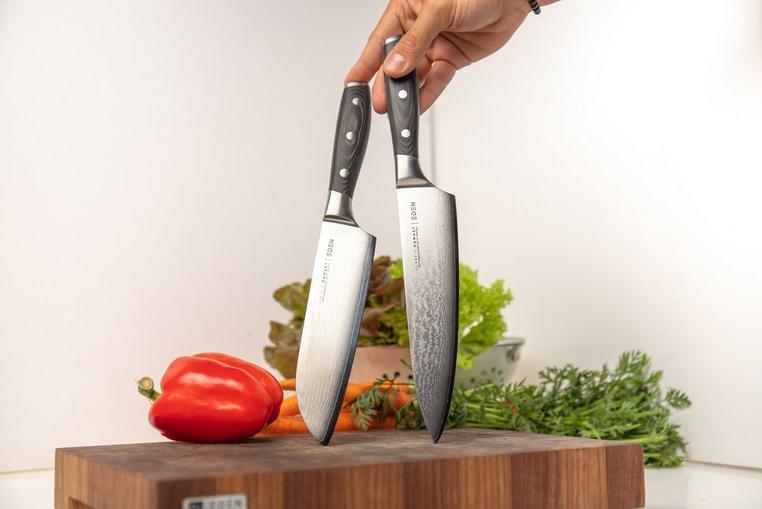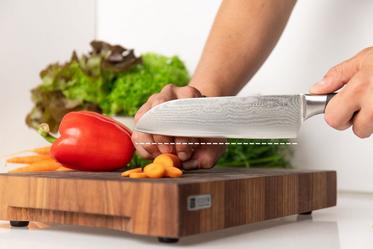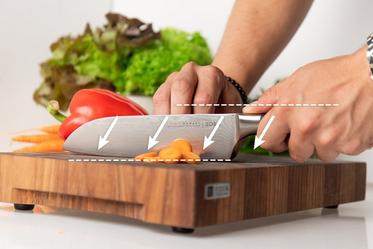Chef’s knife vs santoku: What are the differences
We're often asked: 'What are the differences between a chef's knife and a santoku knife?' The biggest difference is in the shape of the blade. While the blade of a chef's knife ends in a pointed tip, you can see that the santoku slopes from the spine to the edge. Because of this, both knives require different cutting techniques. But you do cut the same ingredients with both types of knife. Which of the two you choose therefore really depends on your preferences. But what exactly are those different cutting techniques? Knivesandtools will explain!
Chef's knife
The chef's knife is characterized by the pointed shape of the blade. Because of this shape, a chef's knife usually has a 'rounded' edge, unlike the straight edge of a santoku.
A chef's knife is the basis of every knife set in Europe because of its versatile blade shape. Cutting with a chef's knife doesn't take much practice, and almost everyone has grown up with them. A chef's knife is a real all-rounder. It's suitable for chopping vegetables, meat and fish. But a chef's knife is also great for tasks that require precision due to the pointed tip.
The convex edge lends itself very nicely to one of the most popular cutting techniques: rocking. It is suitable for finely chopping herbs. Rocking is a cutting technique where you place the tip of the blade on the cutting board, and you bring the heel of the blade to what you want to cut. The tip always remains (approximately) in place and doesn't come away from the cutting board. This creates a rocking motion.
A chef's knife generally has a blade length of between 16 and 24 cm. There are also smaller chef's knives with a blade length of less than 16 cm. But anything smaller than that and you find yourself in paring knife territory.
Want to read more about cutting with a chef's knife? Then read: Five tips to use a chef's knife safely and efficiently.
Santoku
Santokus originated in Asian cuisine and are the Japanese version of the chef's knife. A santoku knife is characterized by its straight edge. In contrast to a chef's knife, the blade is about the same height along its entire length and only slopes down at the tip. Due to the straight edge, the santoku doesn't rock on the cutting surface, as would be the case with a "rounded" edge. This makes it easier to utilize the entire length of the edge when cutting.
The straight edge of the santoku lends itself nicely to the push cut technique. You use a pinch grip for this. This is a technique where you clamp the beginning of the blade between your thumb and index finger. Because you grip the blade close to the handle, you have lots of control over what you're cutting. You cut with a diagonal movement from back-top to bottom-front. After each cut, you lift the blade and return it to the starting position. For this technique, practice makes perfect! When you've mastered it, it's one of the most efficient cutting techniques.
In contrast to the chef's knife, a santoku tends to have a shorter blade length. Most of them measure between 16 and 20 cm. This makes the santoku very popular with chefs and hobby cooks who prefer a shorter kitchen knife.
Want to read more about cutting with a santoku? Then read our how-to: Cutting with a santoku kitchen knife.
Which of the two will you choose?
A chef's knife isn't better than a santoku. And a santoku isn't better than a chef's knife. It's a matter of taste, and which cutting techniques you prefer.











?%24center=center&%24poi=poi&%24product-image%24=&fmt=auto&h=500&poi=%7B%24this.metadata.pointOfInterest.x%7D%2C%7B%24this.metadata.pointOfInterest.y%7D%2C%7B%24this.metadata.pointOfInterest.w%7D%2C%7B%24this.metadata.pointOfInterest.h%7D&scaleFit=%7B%28%24this.metadata.pointOfInterest%29%3F%24poi%3A%24center%7D&sm=c&w=1208)
